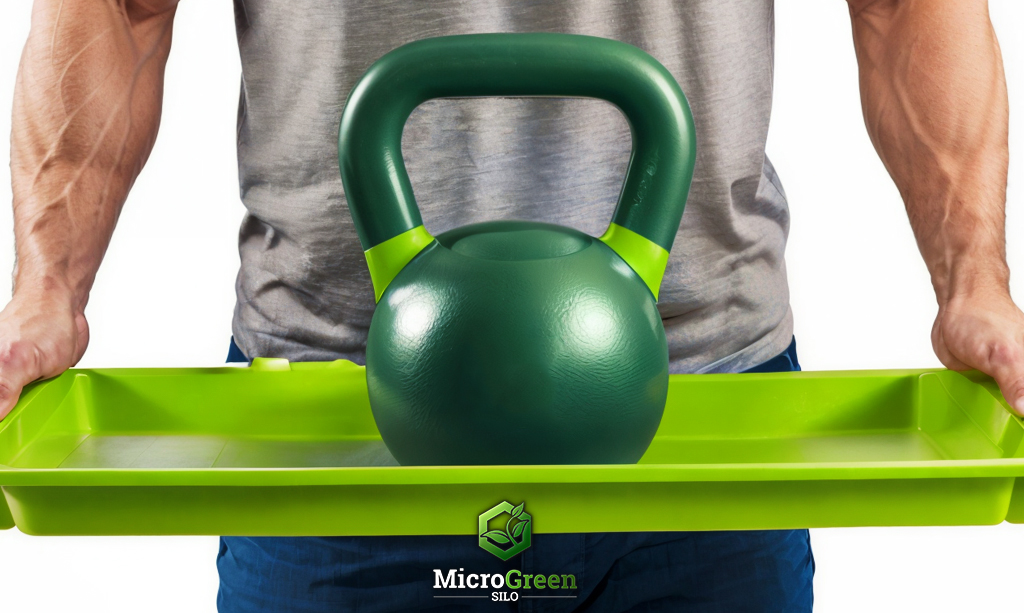
If you are new to growing, you may wonder why microgreens need weight during germination and what it’s for.
Applying weight to germinating microgreens is a crucial growing technique with several key benefits.
Applying weight during germination for microgreens promotes:
- Good seed-to-soil contact
- Moisture retention
- Soil temperature regulation
- Stimulation of root growth
- Upward growth
- Stronger stems
- Reduction in soil erosion
- Pests reduction
Read on, and I’ll show you why microgreens need weight so you can grow your own nutritious and delicious microgreens starting right now!
What’s the purpose of applying weight to microgreens, and how is it done?
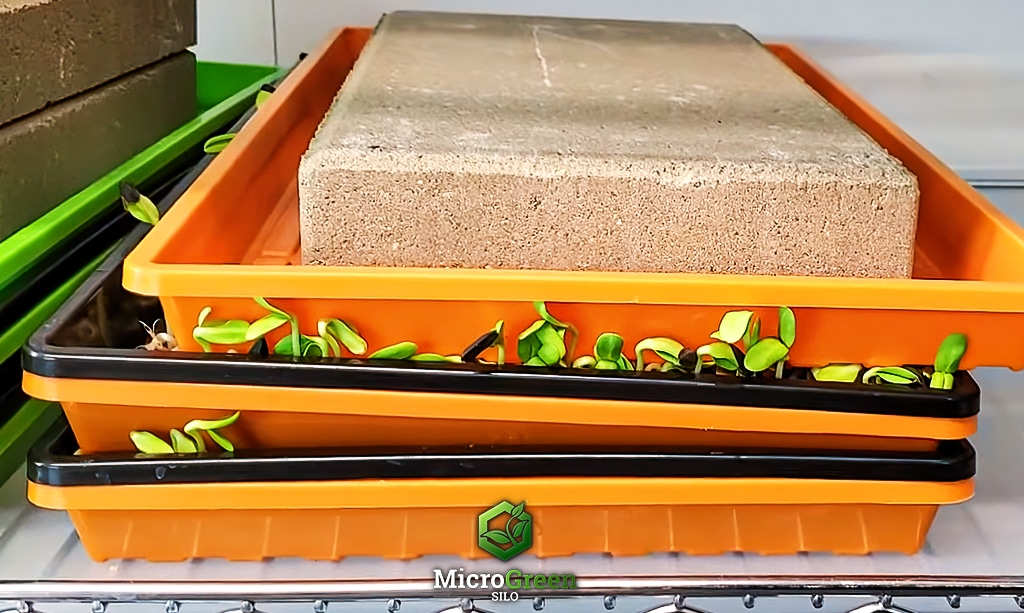
You are all set to start growing your first batch of microgreens, but you’re asking yourself – why do microgreens need weight, and what does it do exactly?
Simply put, it is a clever approach microgreen growers use, in which they place an empty tray with a weight on top of their crops to improve the germination and quality of their microgreens.
The weight can be anything from pavers to bricks or even water-filled bottles!
In a Facebook poll on November 23, 2023, I asked 117 farmers about the weight they use for seed germination. Below are the voting results.
70% of microgreen farmers use pavers and bricks, but some use alternative items like training/gym weights, bags filled with sand or rocks, bottled water, books, and homemade weights.
I prefer pavers and bricks for standard 1020 trays and water bottles for smaller, non-standard trays.
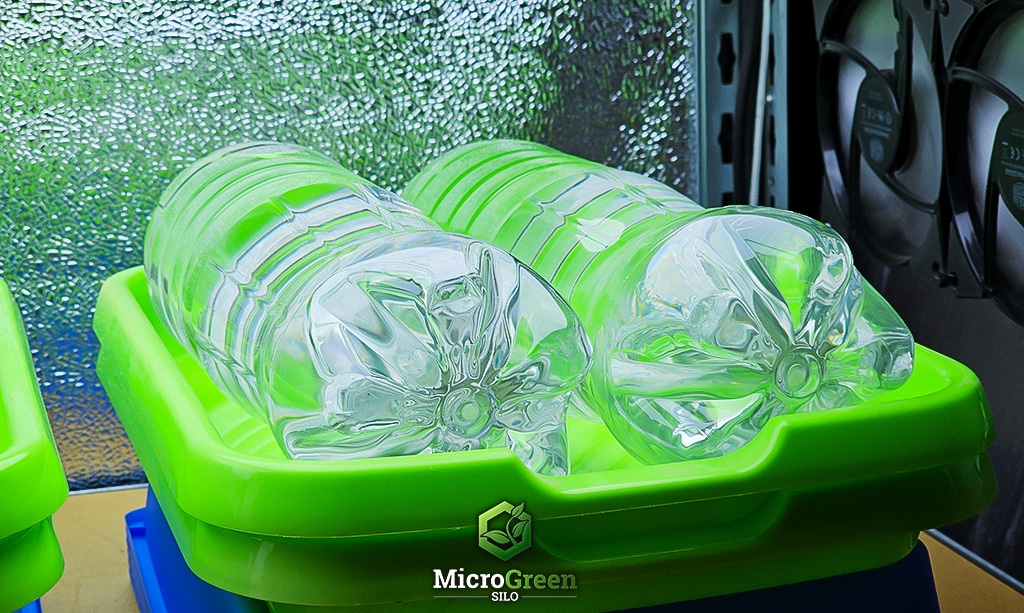
However, many new microgreen farmers overlook the importance of weighing down seeds during germination and may skip it altogether.
Be sure to weigh down your microgreens during germination. Neglecting this step can lead to poor germination or inconsistent growth of microgreens.
Now that you understand what weighing down microgreens means, it’s time to explain why microgreens need weight and how it can improve germination and yield.
Trust me, this technique can work wonders for your crops. So, let’s get started.
Why Microgreens Need Weight During Germination
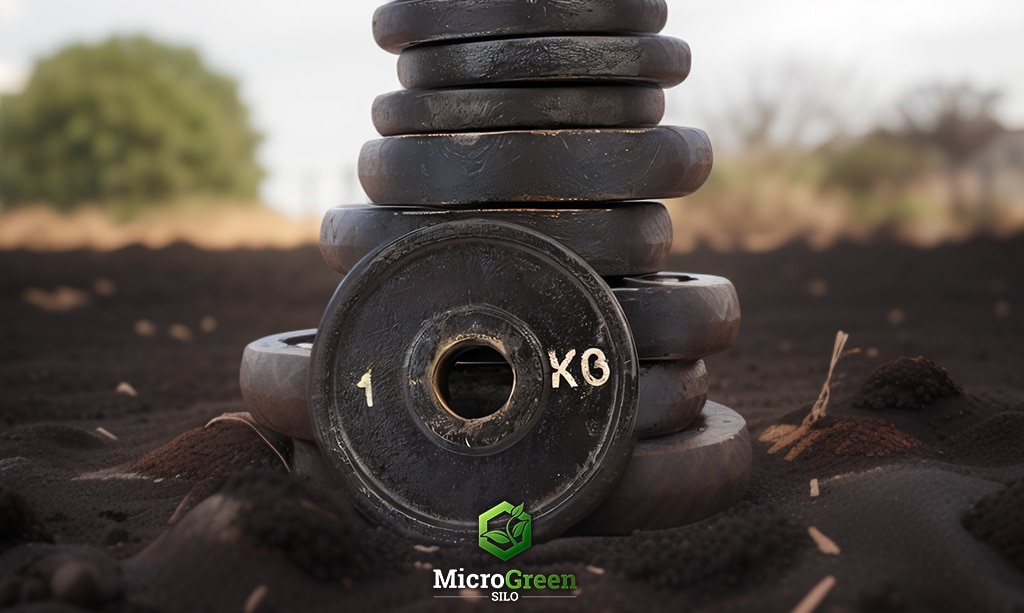
Microgreens provide an easy and convenient way to add fresh and nutritious greens to your diet.
They are easy to grow, nutrient-dense, and suitable for year-round cultivation in small spaces.
One of the most important factors for growing healthy microgreens is to weigh down the germinating trays.
In this section, I will explain eight benefits of weighing your microgreens and why it is essential not to skip this step.
Weight Aids In Good Seed To Soil Contact
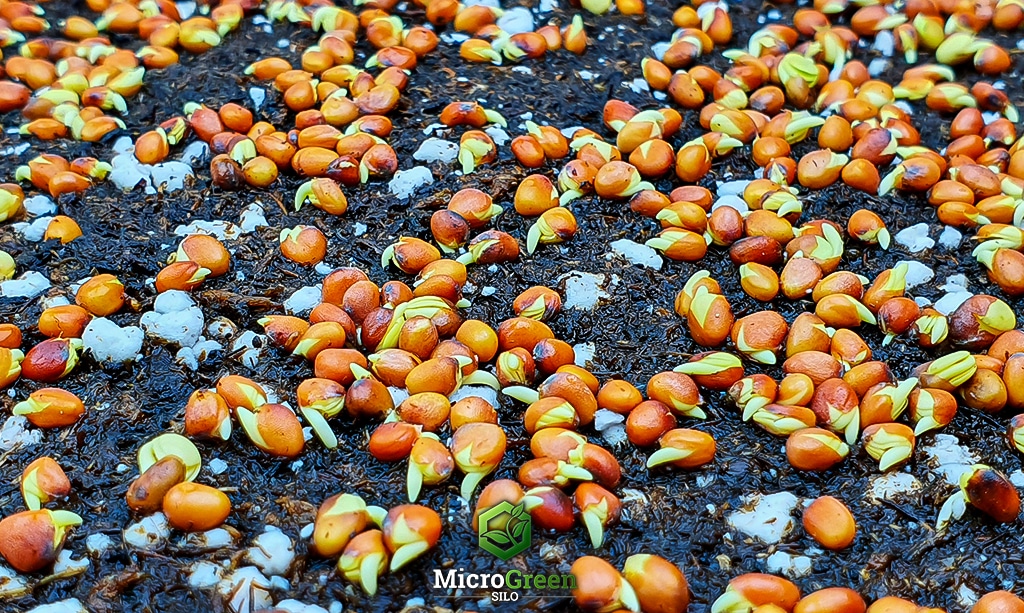
Seeds must have optimal contact with the soil for them to germinate. Weighted trays play a crucial role in achieving this.
When seeds are sown onto the soil surface and covered with a weighted tray, it promotes consistent pressure and contact between the seeds and the growing medium.
By pressing the seeds firmly against the soil, weight helps to ensure that the seeds are in close contact with the soil, which is necessary for water and nutrient uptake.
Weight Helps Retain Moisture
Microgreen seeds need a consistently moist environment to sprout and grow.
Adding weight to the top of the growing medium is essential to maintain good moisture levels.
The weight helps to retain moisture and prevent the growing medium from drying out too quickly, which can cause uneven germination and stunted growth.
During germination, water is absorbed by the seeds from the growing medium, leading to swelling and sprouting.
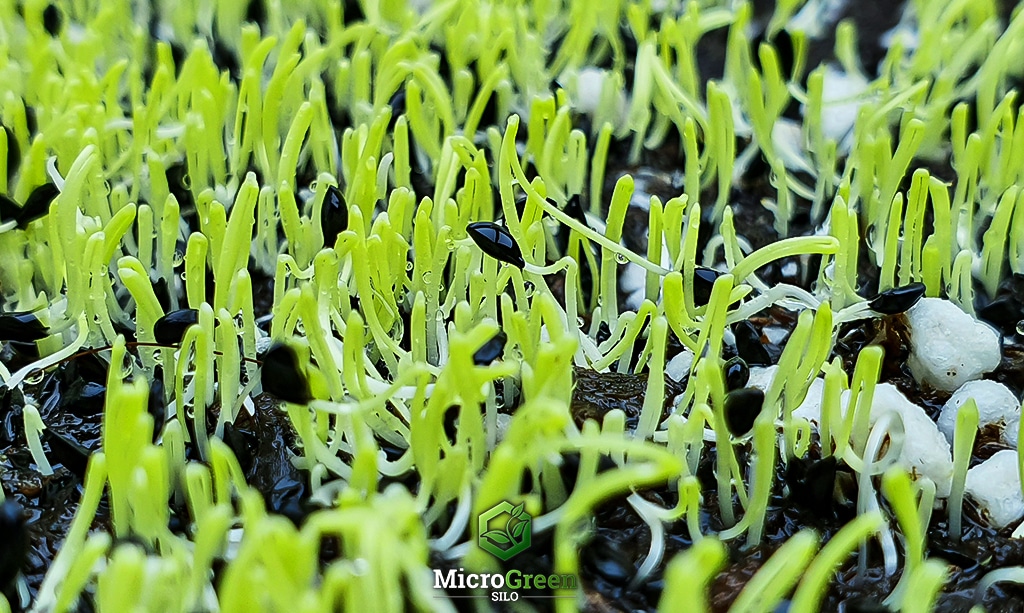
If the medium dries out too quickly, the seeds may not have enough moisture to germinate.
Adding weight to the growing medium allows the seeds to absorb water more efficiently, resulting in faster and more consistent germination.
In addition to retaining moisture, weight helps create a humid environment around the seeds.
This humid environment can help prevent the seeds from drying and reduce the risk of disease and mold formation.
Adding weight to the growing medium is a practical approach to ensure that microgreens receive the necessary moisture to germinate and grow successfully.
Weight Regulates Soil Temperature
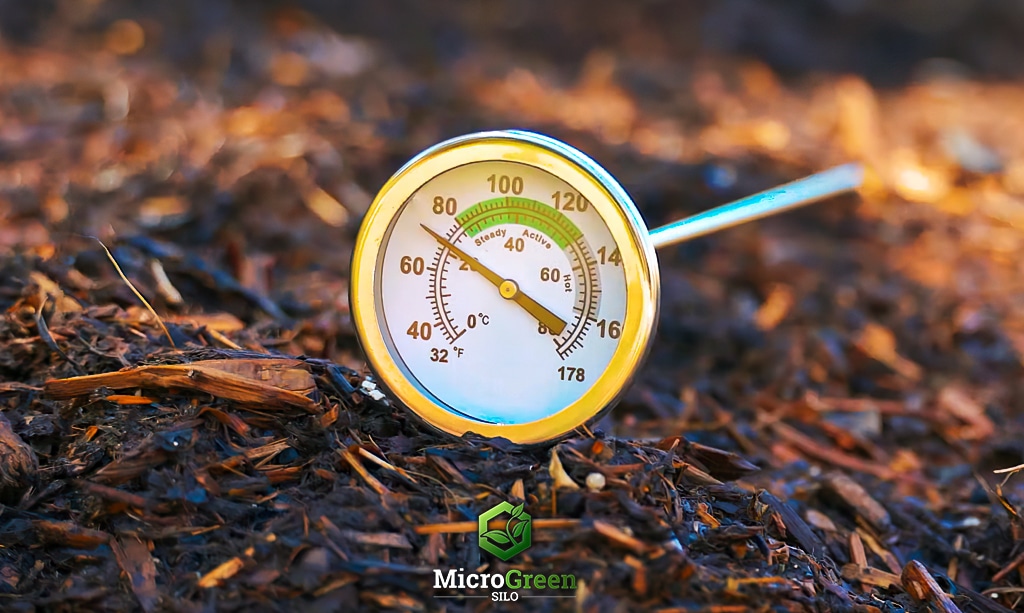
Microgreens are delicate and can be affected by changes in temperature, especially during germination.
To ensure successful germination, you must maintain an ideal soil temperature between 65 to 80°F. I tend to keep my grow room between 74 and 80°F.
However, room temperature, humidity, and airflow changes can make it hard to maintain consistent soil temperatures.
One way to regulate soil temperature during germination is to add weight to the microgreen tray.
Weighted trays provide insulation to the seeds, keeping the soil warm and moist, which is essential for germination.
Additionally, the weight helps prevent evaporation, which could otherwise rapidly dry out the soil.
The strategic use of weight during germination helps maintain a stable temperature.
By firmly pressing the seeds into the soil, this technique provides a reliable barrier against temperature changes, creating the ideal conditions for successful germination.
Weight Stimulates Root Growth
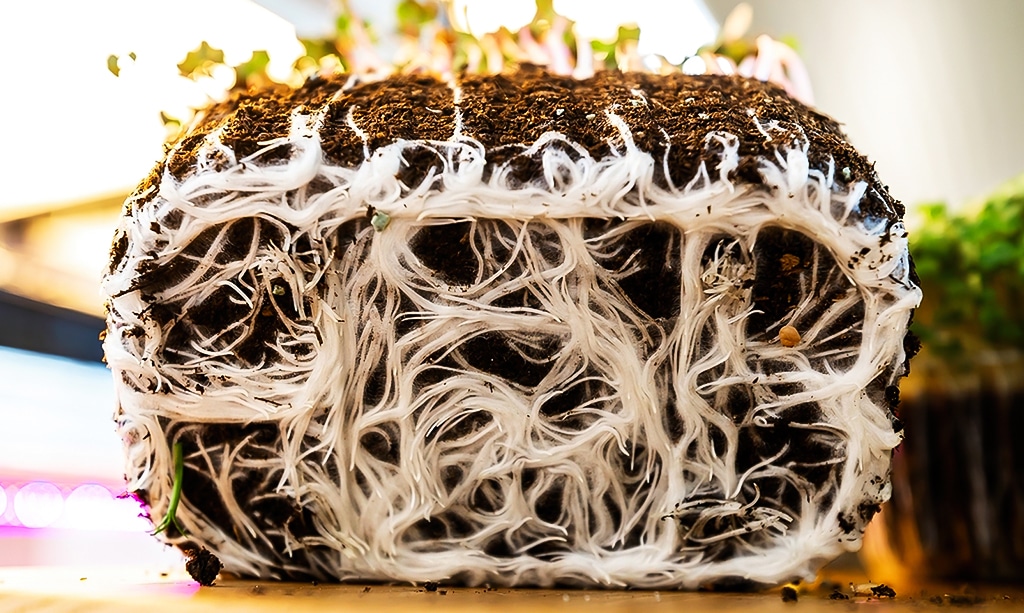
Weight can play a crucial role in facilitating root growth during the germination process of microgreens.
The resistance provided by weight helps develop a sturdy and healthy root system.
Microgreens need resistance to overcome the weight to push through the soil, resulting in more robust roots.
The roots are the foundation of a plant’s growth, as they absorb water and nutrients from the soil, providing the necessary support for its overall health.
Therefore, weight can be a valuable technique to ensure that microgreens have a robust root system, essential for their growth and survival.
Weight Promotes Upward Growth
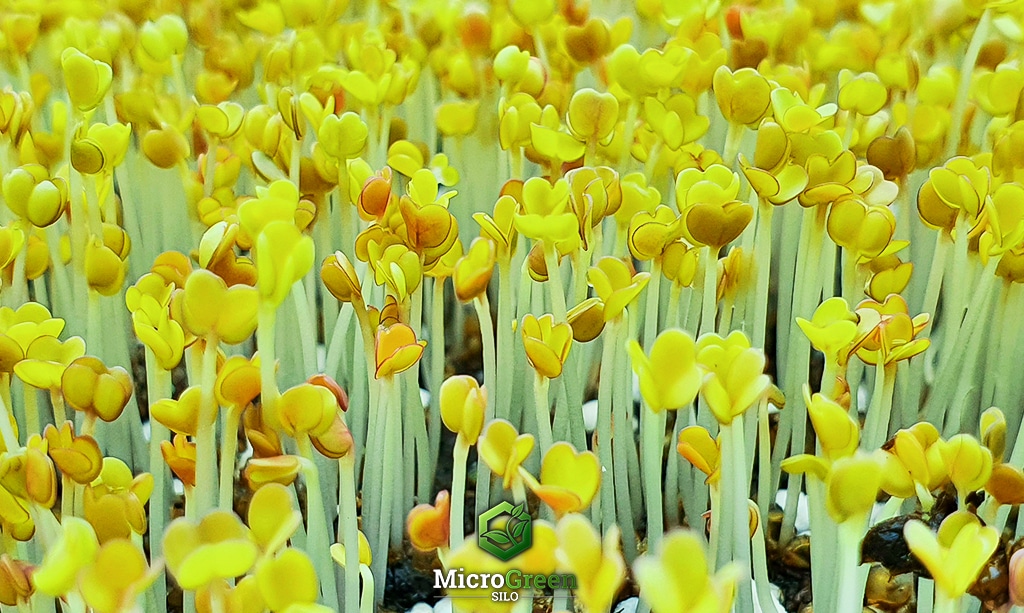
When growing microgreens, it’s essential to apply weight during the germination process to promote upward growth.
Without weight, they tend to grow horizontally and are more likely to develop mold and other diseases.
Adding a weighted tray above the germinating seeds encourages them to push against the tray and burrow into the soil, creating a strong stem and promoting upward growth.
Applying weight during germination is crucial to ensure healthy and robust microgreens.
Weight Strengthens Stems
When growing microgreens, adding weight to the plants is vital to help the stem grow solid and straight.
Weak stems can cause the plant to fall over or break, which can hurt or kill the plant.
Applying weight to the growing microgreens helps the stem become more robust and thicker, facilitating the plant to stand up straight and support itself.
The first stem that grows from the seed is usually thin and weak, but adding weight will strengthen the stem and support the plant better.
Weight Prevents Soil Erosion
One of the main advantages of adding weight to germinating microgreens is that it minimizes soil erosion.
When microgreens are grown without additional weight on the seeds, the soil can shift and move around, exposing the seeds and grouping them. Soil erosion can cause uneven growth and poor germination, and you don’t want that!
Adding weight to the seeds helps hold the soil in place, preventing erosion and ensuring the seeds remain covered.
Overall, adding weight to microgreens during germination is crucial in ensuring they grow strong and healthy.
Weight Can Reduce Unwanted Pests
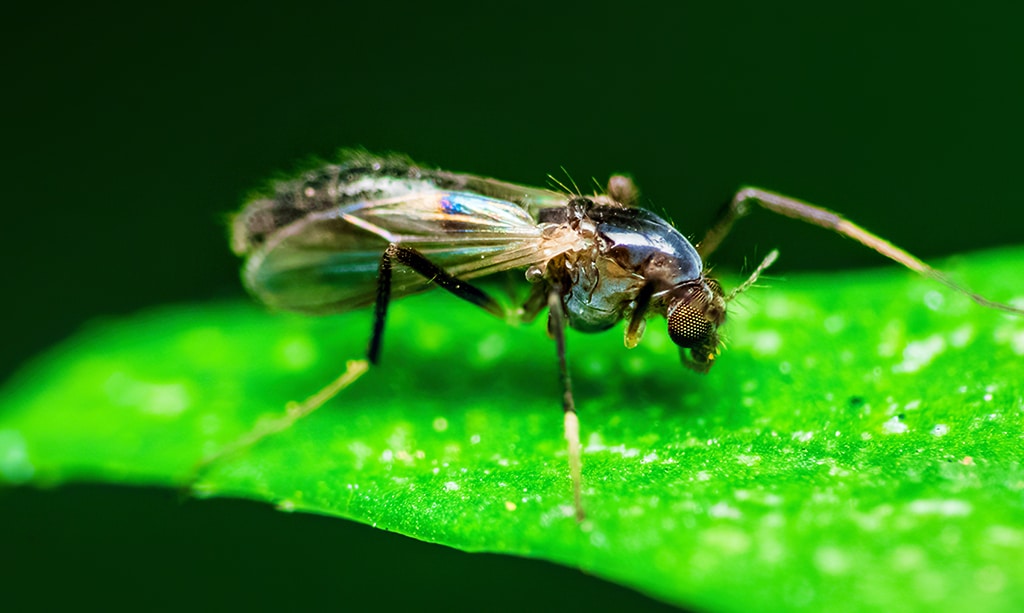
Weighing down seeds is a preventive measure against unwanted pests like fungus gnats.
These pests lay their eggs in the soil, threatening the developing seedlings.
Applying a weighted tray to the seeds makes the soil’s surface less hospitable for these pests, creating a protective barrier that discourages and prevents egg-laying.
Applying weight to your tray safeguards the emerging microgreens from potential harm and promotes a healthier growing environment.
The controlled pressure on the seeds also contributes to a more stable and supportive foundation, aiding the microgreens in their journey toward robust and upright growth.
Types of weight to weigh down microgreens
Most microgreen growers use paving blocks or bricks. But you can use anything that will fit inside the tray and not exceed 15lbs or 6-7kgs.
The commonly used items for weighing down microgreens are pavers and bricks, but some growers use other creative methods, such as:
- Bottles filled with water
- Books
- Bags filled with sand or rocks
- Gym weights
- 4×4 Wood cut to length and stacked side by side
I recommend using pavers, bricks, or water bottles as they are inexpensive and provide even pressure across the tray.
How long to keep weight on microgreens
The duration for keeping weight on microgreens depends on the type being grown.
Generally, most microgreen types prefer weight for 1-4 days; others, like cilantro, can need 7-8 days of weight.
Check out the microgreen types page for in-depth info on all microgreens, their growing preferences, and weight requirements.
What happens to microgreens if weight isn’t used?
If you don’t use any weight after sowing your microgreen seeds, there is an increased risk of the following.
- Poor seed germination.
- Seeds drying out.
- Growing medium drying out.
- Soil erosion from moving the trays or the fans blowing over them disturbs the soil.
- Unwanted pests may lay their eggs in the soil.
- Uneven or sporadic growth.
- Seedlings will grow horizontally, eventually dying.
- Poor seed-to-soil contact, decreasing germination success.
- Soil temperature may fluctuate.
- Weak and spindly seedling stems, causing them to fall over.
The potential downsides of not weighing down your microgreens during germination far outweigh the benefits.
Do all microgreens require weight during germination?
It’s important to know that while most plants can benefit from being weighed down, certain types, like amaranth, don’t require additional weight on top. Instead, an empty tray is sufficient to provide coverage and support.
Amaranth seeds are small and delicate, and the extra pressure may not be helpful during germination.
Growers must understand the specific needs of each microgreen variety they are cultivating.
Factors such as seed size, germination characteristics, and environmental conditions can influence whether or not additional weight is necessary for optimal germination.
Experimentation and observation are vital in determining the most effective germination methods for different microgreens.
Key Takeaway
Adding weight during germination is a crucial technique for growing microgreens, offering numerous benefits such as promoting good seed-to-soil contact, moisture retention, soil temperature regulation, stimulation of root growth, upward growth, stronger stems, reduction in soil erosion, and reduction of pests.
Conclusion
I hope you enjoyed this post highlighting the advantages of adding weight during the microgreen germination process for optimal growth.
Before you plant your next batch of microgreens, make sure to leave a quick comment to let me know if this helped you.
And remember, Keep Your Hands In The Dirt!


